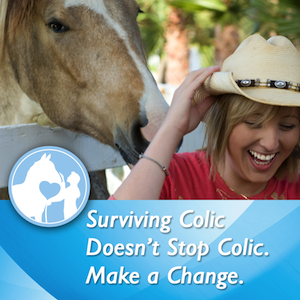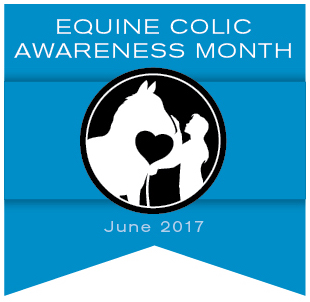 2013 Equine Colic Awareness Month Series Part 2 of 4
2013 Equine Colic Awareness Month Series Part 2 of 4
When your horse colics, knowing the common signs, calling the vet, and getting through even a minor colic is a temporary band-aid, not a permanent fix. Throughout the month of June, the second annual Equine Colic Awareness Month, we will be discussing the importance of colic prevention, why horses are prone to colic, how poor digestive health – as a result of feeding and management – may lead to colic, and what you can do to keep your horse’s gut healthy to reduce colic risk. Surviving colic doesn’t stop colic. Make a Change.
Simply, colic refers to pain anywhere in a horse’s abdomen. This is typically associated with the gastrointestinal tract, and could result from any number of factors including ulcers, parasites, growths (such as tumors), and more. However, conventional use has evolved to when we say a horse “colics” we’re commonly referring to spasms in the GI tract that occur due to gas build-up, blockages, or twists in the colon or, occasionally, the small intestine.
In most cases – more than 80% of them – the colic is deemed “idiopathic,” or “of unknown origin.” And while the veterinarian may have an idea of what occurred, or what gave rise to the colic symptoms, the only way to verify may be through surgery or other tests and procedures that may simply be too costly or impractical. This leaves owners in the dark much of the time about what leads to colic and, thus, how to avoid it.
What we do know is that many of the ways we feed and manage our horses compromises the health of the equine gut in a way that may create an environment where colic is more likely.
What We Feed Puts Horses at Risk for Colic
The equine gastrointestinal system is designed to slowly, steadily, and constantly digest small amounts of fibrous foods: primarily a mix of grasses as well as seeds and bark. In the wild, horses graze up to 18 hours a day while roaming slowly over great distances.
However, because our horses are in work and have greater energy requirements, we nearly always add a hard or concentrated feed into their diet: sweet feeds, oats, pelleted feeds – the options are almost endless. Even hard feeds that are touted as “low-starch” contain more than what the equine system should handle, which can upset the delicate health and balance of the hindgut.
Studies have found that grain-fed horses colic astronomically more often than forage-only fed horses, especially when they are also stalled, trailered, ridden, and/or competed.
How We Feed Puts Horses at Risk for Colic
Limiting Turnout and Access to Forage
Horses are trickle feeders, which means they need to be grazing on small amounts of quality hay and grass nearly around the clock in order to be most healthy. This helps to buffer stomach acids, which are constantly produced, while providing fuel for the hindgut where fiber is fermented slowly over several days to generate up to 70 percent of a horse’s energy.
When horses are turned out on quality pasture less than 18 hours a day, are fed only 2-3 times a day, and/or spend hours at a time with nothing to munch, their digestive health may be compromised.
Large Meals and Overfeeding
We’ve all heard horror stories about the weekend horse-sitter who unknowingly gave a horse way too much grain, or of horses breaking into the feed bin, and colicking. But did you know that a hard feed meal of more than 5 pounds at a time can be too large for a horse to handle?
Starches should be digested and absorbed before reaching the hindgut. Because feed moves through the stomach and small intestine in a matter of hours, a hard feed of that size goes through too quickly for the starch to be properly digested in the foregut.
Other Management Factors That May Contribute to Poor Gut Health
Because the equine gut is so delicate, there are many common mistakes people make that may contribute to poor gut health and may lead to colic:
- Not building up on spring grass slowly over a period of weeks
- Not checking actual water intake (in addition to ensuring access to plenty of clean water around the clock)
- Not turning out for long periods or at all, which inhibits movement that helps with digestion
- Not utilizing a consistent feeding routine
How We Use Horses Increases Colic Risk
Horses in the wild expend little energy; they walk slowly for miles as they graze and only heighten their pace in short bursts to escape from a perceived (or real) predator.
On the other hand, we often ride our horses regularly – and at more than just a walking pace. Some of us train hard and compete at least a few times a season, and often more. We trailer horses out to show or to trail ride or for lessons. And all of this can stress both the horse’s digestive processes and mental health, which can also impact gut health.
So, What Do We Do With This?
If your horse is kept with even one of the factors mentioned above, he or she could be at risk for sub-optimal gut health that could open the door to colic.
In next week’s installment of this four part Colic Awareness Month series, we will discuss the specific reasons poor digestive health as a result of these feeding and management factors may result in colic. We will conclude the series with tips for steps you can take to support your horse’s overall gut health – and therefore reduce the risk for colic.
Be sure to subscribe to the Crusade Blog and to Join the Crusade email list so you don’t miss out on any of the important information and stories we will be sharing throughout the month of June. Also check out the various ways you can participate in Colic Awareness Month – including some opportunities to win great prizes for you and your horse.






